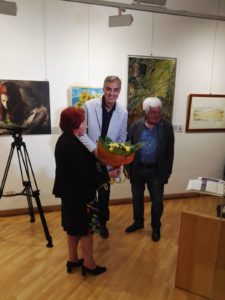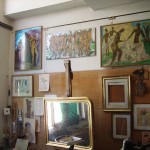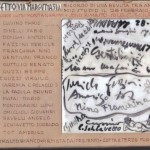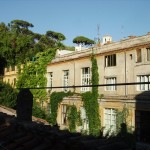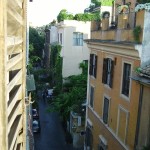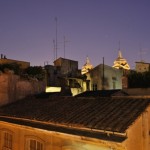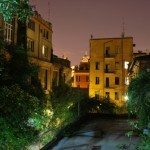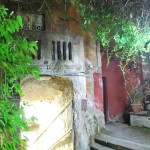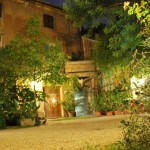Notizie
Segni in movimento
Nella suggestiva cornice di via Margutta dal 14 al 27 giugno 2018, si è svolta una mostra collettiva di arti visive che ha raccolto un piccolo numero di artisti selezionati dalla galleria Consorti. A questi ultimi è stata data la possibilità di mostrare i propri lavori inseriti con estrema accuratezza visiva nello spazio della galleria.
Articolo sul quotidiano LA Voce 19 giugno 2018
Articolo sull’Attualità luglio agosto 2018
Rassegna internazionale di arti visive
In occasione della presentazione dell’ultimo numero di dicembre della rivista “Segni d’Arte”
nei saloni del Centro Culturale Egiziano è stata allestita una mostra di arti visive, che ha visto
la partecipazione del direttore dell’ufficio culturale e scientifico egiziano il prof. abdelrazek fawky.
SULLA PRESTIGIOSA RIVISTA E’ STATO PUBBLICATO SU UN INTERA PAGINA L’ARTICOLO
DELLA MIA MOSTRA AL FOYER DELLA SALA UMBERTO IN OTTOBRE. locandina_Egitto2013_ALTA
La mia storia
Storia dello Studio di via Margutta 51/a
Un evento luttuoso avvenuto nel mese di luglio del 2011, segna la mia strada di artista. La morte del professore Corrado Schiavetto. Con lui si chiude anche lo studio di via Margutta al n. 51/a, e pertanto credendo di fare cosa gradita ai tanti amici e conoscenti che come me hanno avuto l’opportunità di seguire i suoi insegnamenti, racconto la sua storia artistica.
Nel 1936 nasceva uno studio di pittura in via dell’Anima, 92 (piazza Navona) per opera di due giovani artisti: Corrado SCHIAVETTO e Angelo SAVELLI. Lo studio era la meta abituale di studenti che frequentavano l’accademia di Belle Arti di Roma. Tra gli studenti c’era il pittore, loro ospite, Carlo BARBIERI che fece conoscenza con la Sig.ra Angela STREHELER e la sua famiglia che gli comprarono alcuni dei suoi quadri. Carlo Barbieri conobbe in quel contesto anche gli architetti MACIOCCI e LIZZANI collezionisti di quadri e l’avvocato Lucifero (amico di A. Savelli) che si offerse gratuitamente per la sua difesa nel processo NICHILO’ (che suscitò molto scalpore nelle cronache dell’epoca). Nello studio furono nascosti i famosi quadri del processo.
La guerra portò i pittori lontano, sui campi di battaglia. Corrado Schiavetto nell’aeronautica ebbe il grado di Tenente pilota e dopo la terza caduta con l’aereo, fu dichiarato invalido e quindi congedato nel 1943.
Tornò a Roma e senza casa, occupò un appartamento che diventò la sua abitazione studio. Era stato lasciato libero da una signora che collaborava con i tedeschi ed era fuggita prima della liberazione. Sarebbe stato assegnato successivamente ad un capitano dell’esercito americano, il quale autorizzò l’occupazione. La nuova abitazione si trovava in via Margutta, 51/a ed era stata costruita nel XIX° secolo proprio per essere destinata agli artisti, come tutti gli altri appartamenti che erano nello stesso complesso.
Ricominciò qui con A. Savelli che alloggiava però al n. 49 della stessa via, il suo percorso artistico. Aprì in quegli anni un laboratorio di ceramica al n. 7 di via Margutta e avvalendosi della collaborazione dei tanti suoi amici quali: Pericle FAZZINI, Angelo SAVELLI, Amerigo TOT, Nino FRANCHINA, Orfeo TAMBURI, Franco GENTILINI, Antonio DONGHI, Luigi MONTANARINI, (vedi in fondo alla pagina la foto di una mattonella bianca firmata da tanti di loro). Lavorò molto con l’architetto PIACENTINI e portò a compimento numerosi e importanti lavori. Vanno ricordati tra questi le decorazioni effettuate nei cinema Fiamma, Fiammetta, Cosmo, Arcobaleno e Sistina, in quest’ultimo sono ancora visibili le ceramiche sul rivestimento delle colonne della galleria. Realizzò il rosone sulla facciata esterna della chiesa “dello spirito santo” progettata dallo stesso Piacentini a Pescara. Tra le sue opere si annoverano anche le decorazioni in ceramica effettuate su alcune navi da crociera italiane dell’armatore Achille Lauro: il Roma e il Sidney. In collaborazione con la moglie, realizzò l’affresco, situato sulla facciata esterna dell’edificio all’angolo del vicolo di S.Trifone a Roma, dedicato all’omonimo santo, andato distrutto in questi ultimi anni a causa di un incendio vandalico.
Cliccando sul link in basso è scaricabile un file in excell ove sono elencati alcuni dei suoi lavori che sono stati eseguiti negli anni. Lavori di ceramica e arredamento
Corrado SCHIAVETTO è stato professore di belle arti presso istituti scolastici di Roma e di Latina, nonché esperto conoscitore delle opere di Angelo SAVELLI e Carlo BARBIERI. (A. Savelli si stabilì in seguito negli Stati Uniti d’America ottenendo notevoli riconoscimenti con le sue opere geometriche “in bianco”). Per la sua conoscenza di Carlo Barbieri e del fratello scultore, fu nominato dall’Amministrazione Provinciale di Lecce collaboratore per l’allestimento del catalogo e della mostra, dedicata a lui nel 1981, presso il museo provinciale di Lecce. In quella occasione inviò anche i quadri di sua proprietà: “Il tubo della stufa”, “Il fratello Ugo”, “Madonna con bambino” (disegno) che furono inseriti sullo stesso catalogo.
La sua collezione nel corso degli anni, si è arricchita di quadri ad olio, stampe, disegni, cornici e rispecchia in buona parte il periodo della “Scuola romana”. Nell’intera collezione compaiono anche tele di importanza storica e di notevole grandezza quali una allegoria della Gerusalemme Liberata, attribuita attraverso attente ricerche al pittore contemporaneo dei f.lli Carracci, Michele DESUBLEO. Altre due opere, di notevoli dimensioni e a soggetto sacro sono appartenenti alla scuola napoletana,:“l’Annunciazione” e “La deposizione”. Sono inoltre presenti quattro quadri, di dimensioni piu’ piccole, di evidente esecuzione ottocentesca, del genere a natura morta con raffigurazione di cose e animali, firmati dall’artista veneto Minozzi Eraclio, nato a Vicenza nel 1847.
Alcuni quadri sono stati realizzati dai tanti allievi che si sono avvicendati presso i suoi studi, altri sono oggetto di suoi acquisti effettuati nel corso degli anni o regalatigli dagli artisti stessi, (come il ritratto di Montanarini fatto da Tamburi, un nudo di donna di Montanarini). Tra i disegni ce ne sono alcuni a firma di Morandi (acquisiti durante la sua permanenza a Bologna a seguito del ricovero subito dopo il suo ultimo incidente aereo), altri sono firmati da A. SAVELLI, TOT, DONGHI, GENTILINI, FRANCHINA e altri. Molti di questi ultimi disegni sono stati il frutto di spensierate e giocose serate vissute nei loro luoghi di ritrovo situati intorno a via Margutta.
Altri quadri sono stati dipinti dalla pittrice di origine olandese e romana di adozione, Clara Van Den Brandeler, moglie del prof. Schiavetto. Nello studio erano presenti alcune stampe a rilievo e serigrafie di A. Savelli, xilografie di G.Cena, P.Fazzini e numerose cornici antiche. Alcune cornici sono di tipo a “cassetta”, tipiche dell’Italia centrale del secolo XVI°, mentre altre di fattura diversa sono del XVIII° e XIX° secolo.
Nell’abitazione studio di C. Schiavetto si sono avvicendati negli anni molti allievi, tra gli ultimi a frequentarlo ci sono stato io, da lui nominato legalmente come suo erede artistico.
Va infine ricordato che lo studio si affaccia su un cortile che è stato consacrato da famosi film internazionali, primo fra tutti il famosissimo “Vacanze romane” con Gregory Peck e Audrey Hepburn.
Sulle foto allegate si possono osservare le firme degli artisti suoi amici e alcune immagini riprese dalle finestre e nel cortile di via Margutta 51:
- Interno dello studio Schiavetto
- Testimonianza di una bevuta tra amici.
- Alcuni studi degli artisti nel cortile al 51a
- Vista su via Margutta
- Vista sui tetti dallo studio
- Esterni sullo studio
- Il balcone di “Vacanze romane”
- Nel cortile
History of the Study of Margutta 51 / a
The following history of the study that I have attended assiduously since 1998 has been published by me in gratitude and appreciation towards the Ceramist / painter CorradoSchiavetto, who died in July of 2011.
In 1936, a painting studio on via dell’Anima, 92 (Piazza Navona) through the work of two young artists: Conrad Schiavetto and Angelo Savelli. The study was the usual destination of students attending the Academy of Fine Arts in Rome. Among the students was the painter Carlo Barbieri, almost always their guest. In the study took place between the knowledge Carlo Barbieri and Ms. Angela STREHELER with his family who bought some of his paintings.
Carlo Barbieri experienced in that context Maciocco architects and collectors of paintings LIZZANI Lucifero and the lawyer (a friend of A. Savelli) which is offered free of charge for the defense (?) In the process Nichilo'(?). In the study of famous paintings were hidden process. (?)
The war took away the painters, on the battlefield. Corrado slave in the Air Force had the rank of lieutenant and pilot with the aircraft after three drops was recognized invalid and then discharged in 1943.
He returned to Rome, without a house, occupied an apartment, (abandoned by a German family and destined for a U.S. Army Captain), and made his home studio. The new house was in Margutta, 51 / a and was built in the nineteenth century precisely because they are intended for artists.
She began here with A. Savelli (No. 49), the friend, his artistic career. He opened at that time a pottery workshop at no 7 the same way, and with the collaboration of many of his friends, patrons already on dell’Anima study, such as Pericle Fazzini, Angelo Savelli, Amerigo Tot, Nino Franchina, Orpheus DRUMS, Franco Gentilini, Antonio DONGHI, Montanarini Luigi, the architect Piacentini and others, he carried out many important works. It should be noted between these decorations made in the film Flame, Fiammetta and the theater still visible in parts of the Sistine Ceiling (oval) and the columns of the room (low-relief coating). In collaboration with his wife, created the fresco, located on the external facade of the building at the corner of the alley of St. Tryphon in Rome, dedicated to the eponymous saint, destroyed in recent years due to a fire. The rose ceramic on the outer facade of the church “Spirito santo” designed by Piacentini in Pescara.
Schiavetto Corrado was professor of art at schools in Rome and Latina, and expert on the works of Angelo Savelli, Carlo Barbieri. (A. Savelli later settled in the United States of America gaining considerable recognition with his work of “white”). In addition to his knowledge of his brother Carlo Barbieri and sculptor, was appointed by the Province of Lecce collaborator for the preparation of the exhibition catalog and performed in 1981 at the Provincial Museum in Lecce, dedicated to Carlo Barbieri. On that occasion also sent pictures of his property: “The stove pipe”, “Hugh’s brother,” “Madonna with Child” (drawing) that were placed on the same catalog.
His collection over the years, has been enriched by oil paintings, prints, drawings, frames and covers much of the period of the “Roman School”. Also appear in the collection of important paintings of notable historical significance and magnitude as an allegory of the Gerusalemme Liberata, which he attributed, through careful research to Agostino Carracci. Two other works, large and belonging to the Neapolitan school, are sacred subject: “The Annunciation” and “The Deposition”. There are also four pictures, plus size ‘small, clearly running the nineteenth century, the genre of still lifes depicting objects and animals on display, signed by the Venetian Minozzi Heraclius, who was born in Vicenza in 1847.
Some paintings were made by the many students who have come and gone from his studies, others are subject to purchases made over the years given him by his friends and artists (such as the portrait done by Montanarini drums). Among the drawings, there are some signed by Morandi (acquired during his stay in Bologna as a result of the hospital soon after his latest incident plane), others are signed by SAVELLI, TOT, DONGHI, GENTILINI, FRANCHINA and other friends. Many of these designs were the result of thoughtless and playful evenings lived in their venues situated around Margutta.
Other paintings were painted by a painter of Dutch origin, but Roman by adoption, Van Den Brandeler Clara, wife of prof. Schiavetto. In the present study had some relief prints and screen prints of A. Savelli, woodcuts by G. Cena, P. Fazzini and numerous antique frames. Some frames are of type “box”, typical of central Italy in the sixteenth century, while others have different piu’recenti bill (sec. XVIII and XIX).
In the home / studio of C. Shiavetto always a lot of students have come and gone, among them there are also some contemporary art and the prosecutor, guardian of his memoirs, the painter / ceramicist Stefano GIACHE”.
It should also be noted that the study overlooks the courtyard, location of some films, among these was the famous shot “Roman Holiday” with Gregory Peck and Audrey Hepburn.
On the attached picture you can see the signatures of his artist friends and some images from the windows and in the courtyard of Margutta 51:
This is what I learned from the professor, about the history of his acquaintance with Angelo Savelli
Savelli A. After graduating in Calabria, came to Rome to join the Academy of Fine Arts, housed on their own. He kept to the studies through a monthly sum made available by his family that allowed him to survive.
He met with Corrado Schiavetto in the Academy, if he himself wanted to attend a course on knowledge of the techniques in the art. C. Shiavetto was not graduated, in fact, told of being in possession of a certificate of professional master decorator obtained at an Institute of Arts, which is why he had difficulty to be inscribed. The main obstacle was represented by Professor Director of the course to which slave, appealing to his artistic ability and experience gained in those years, living next to so many artists, all kinds of pressures exerted by those able to be inserted.
And ‘what was the only test supported by the Academy in Rome slave who later following a ministerial competition, thanks to his innate ability, turned the first absolute and was hired as a professor of fine arts.
Shiavetto lived for some time alone (being gone from home at age 17 following a dispute with his father), via dell’Anima (behind Piazza Navona) a home / studio where she struggles to pay the rent, so he offered to the Savelli ability to share your accommodation to participate in making expenditures. From that moment began a period of work and friendship that will end only a few years later when A. Savelli decide to go to America.
The links below are listed some of the works that have been made on the premises of ceramics Margutta No 7 from 1946 to 1958, with references to artists who in turn worked with him.
Lavori di ceramica e arredamento
All content is protected by copyright | © 2011 by Stefano Giachè.
Subscribe to RSS Feed – Articles or Comments
Made with WordPress
Graph Paper Press graphical theme
